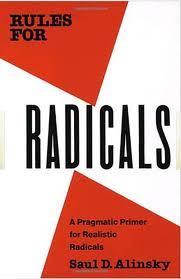The two-fold purpose of this course is to make you aware of Alinsky’s rules so you can SEE them being used and refute them as appropriate; and to give you ideas about how you might USE some of the rules to better organize and work toward positive change on your campus or in your sphere of influence.
SEEING THE RULE
One essential key to success from Alinsky’s viewpoint is to create the perception of momentum. The effective organization will gain the audience’s sympathy and energy. The status quo has to become the “bad guy” and the organizing group must be seen as the “good guys” coming onto the scene to bring positive change.
Alinsky is clear that you do not need to be the largest group to effect change. In fact, he contends that the “good guys” (as he defines them) will always be the minority. But he also asserts that with organization, clarity, and energy, small groups seeking change can win the day. He gives us a metaphor from the human face to explain how to mobilize the perception of strength:
For an elementary illustration of tactics, take parts of your face as the point of reference: your eyes, your ears, and your nose. First the eyes; if you have organized a vast, mass-based organization, you can parade it visibly before the enemy and openly show your power. Second the ears; if your organization is small in numbers, then do what Gideon did: conceal the members in the dark but raise a din and clamor that will make the listener believe your organization numbers many more than it does. Third, the nose; if your organization is too tiny even for noise, stink up the place. (p. 126)
USING THE RULE
“Politically correct” thinking dominates most campus environments today. Minority voices have to learn to use proven methods of communication if they want to be heard, and expect to make an impact. Rule #1 proposes that those who oppose you must perceive your passion; and they must also perceive that you have a group that can be mobilized behind you. Your confidence and boldness can prompt a response from people who are in power, Alinsky writes, even if they are predisposed against you.
The quickest and most fundamental aspect of the organizing process is to be able to clearly state what you are seeking to do. Don’t just react; act with purpose. It has been said that “nothing is dynamic until it is specific.” If you can capture your mission in a clear and pithy statement, you are ready to launch into a plan with a perception of focus. And focus breeds momentum.
The other key to benefiting from this rule is passion. As you watch the LI Case Videos and read the rules to follow, note that central to each is people with passion. Doing something to be doing something is not going to provide enough energy to push through the resistance that will come with any meaningful endeavor to change a culture. However, gather up a group – even a small group – of impassioned people and they can accomplish huge things. In part, this is because they create a perception of momentum and energy that can be intimidating to ideological opponents. Here’s an example of how perception can become reality, even at the level of national opinion:
“Power is not only what you have, but what the enemy thinks you have.”








